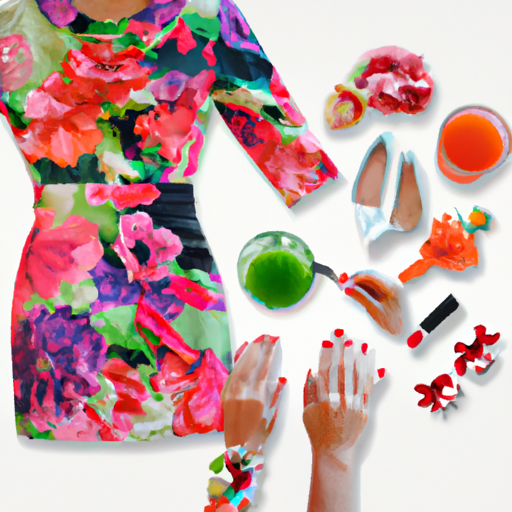You’ve always wanted to add a pop of color and creativity to your wardrobe, but buying expensive dyes and dyeing kits can be a hassle. Well, look no further because we’ve got the perfect solution for you! Introducing “How To Dye Clothes With Acrylic Paint” – a revolutionary guide that will teach you how to transform your plain old clothes into vibrant works of art using just acrylic paint. Whether you’re a novice or an experienced artist, this easy-to-follow tutorial will show you step-by-step instructions on how to achieve stunning results and breathe new life into your wardrobe. Get ready to unleash your inner fashion designer and create unique, personalized masterpieces that are sure to turn heads.

Preparation
Before you dive into the exciting world of dyeing clothes with acrylic paint, it’s important to gather all the necessary materials. Here’s a list of what you’ll need: clean clothes to dye, acrylic paints, fabric medium, brushes, sponges, scrap fabric for testing colors, a workspace with a protected surface, and protective clothing like aprons and gloves.
Choosing the right acrylic paint is crucial for achieving vibrant and long-lasting colors. Look for paints that are specifically labeled as suitable for fabric painting. These paints are typically formulated to adhere well to fabric fibers and withstand washing. Additionally, consider the color selection and choose paints that match your desired outcome.
Now that you have your materials ready, it’s time to select the clothing you want to dye. Opt for clothes made of natural fabrics, such as cotton or linen, as they tend to absorb the paint better. Avoid synthetic fabrics like polyester, as they may not hold the color as well. Also, make sure the clothes are clean and free from any stains or spots, as these can affect the dyeing process.
Preparing the workspace is essential to ensure a smooth dyeing process. Cover your work surface with a plastic sheet or old newspapers to protect it from any paint spills or stains. This will also make cleanup easier later on. Arrange all your materials within reach, and make sure there’s enough ventilation in the room to allow the paint fumes to dissipate.
Clothing Preparation
Before you start applying the paint, it’s crucial to properly prepare the clothing you want to dye. Begin by washing the clothes to remove any dirt, chemicals, or sizing agents that may interfere with the dyeing process. Follow the manufacturer’s instructions for washing, and make sure the clothes are completely dry before proceeding.
If you notice any stains or spots on the clothing, take the time to remove them before dyeing. Use an appropriate stain remover or spot cleaner and gently treat the affected areas. Remember to follow the instructions on the product and test on a small inconspicuous area first to ensure it doesn’t cause any damage or discoloration.
To ensure the best absorption of the acrylic paint, it’s essential to pre-treat the fabric. This can be done by dampening it with water or a mixture of water and fabric softener. Lightly mist the fabric or soak it in the solution, then wring out any excess moisture. Pre-treating the fabric helps open up the fibers, allowing the paint to penetrate more effectively.
Acrylic Paint Mixing
Before you begin dyeing your clothes, you’ll need to mix the acrylic paint with fabric medium. The fabric medium serves as a binder, helping the paint adhere to the fabric and retain its softness and flexibility. Follow the instructions on the fabric medium bottle for the recommended ratios, as they may vary depending on the brand.
Select the paint colors you want to use for your design. Acrylic paints come in a wide range of colors, so feel free to experiment and mix different shades to achieve your desired look. Use a palette or a disposable container to mix the paints. Add the fabric medium gradually while stirring until the paint and medium are fully blended.
To avoid any surprises and ensure the desired color outcome, it’s crucial to test the mixed paint on a scrap piece of fabric. This can be a small swatch of the same fabric as your clothing or a similar material. Apply a thin layer of the paint mixture using a brush or sponge and let it dry completely. This will give you a preview of how the color will look on your clothing.
Dyeing Techniques
There are various techniques you can use to apply the acrylic paint to your clothing. Each technique yields a different effect, so feel free to explore and combine them to create unique designs. Here are some popular dyeing techniques to consider:
Brush Application
Brush application is the most straightforward method and allows for precise control over the paint. Dip a brush into the paint mixture and apply it directly to the fabric. You can create strokes, patterns, or even write words with the brush. This technique is great for detailed or intricate designs.
Dip-Dyeing
Dip-dyeing involves submerging parts of the clothing into a dye bath. Prepare a container filled with the mixed acrylic paint and fabric medium solution, and dip the desired areas of the fabric into the mixture. You can achieve gradient effects by gradually lifting the fabric out of the dye bath, allowing the paint to blend naturally.
Sponge Technique
Using a sponge can create unique textures and patterns on the fabric. Dip a sponge into the paint mixture and dab it onto the fabric. You can use different types of sponges and experiment with different pressure levels to achieve various effects. This technique is great for creating abstract or organic designs.
Spray Method
The spray method allows for a more subtle and airbrushed look. Fill an empty spray bottle with the paint mixture and adjust the nozzle to achieve your desired spray pattern. Hold the bottle several inches away from the fabric and apply the paint in a light and even manner. This technique is perfect for creating ombre or fading effects.
Tie-Dyeing
Tie-dyeing involves twisting, folding, or tying the fabric before applying the paint. This technique produces unique and vibrant patterns. There are various tying and folding methods you can explore, such as the classic spiral or the accordion fold. Apply the paint to the tied fabric, making sure to saturate all the layers. Allow the fabric to sit for some time before rinsing and untying.

Applying the Paint
Now that you’ve chosen your dyeing technique, it’s time to apply the paint to your clothing. Here’s how to get the best results:
Prepare the paint for application by stirring it well to ensure it’s mixed evenly. This will help prevent any inconsistencies in color or texture. If the paint seems too thick, you can add a small amount of water or fabric medium to thin it out.
Start with light layers of paint to avoid saturating the fabric too quickly. This allows for better control over the color intensity and helps prevent the paint from feeling stiff or cracking when dry. Apply the paint using the chosen technique, whether it’s brushing, spraying, sponging, or dip-dyeing. If desired, you can dilute the paint with water or fabric medium to achieve a more translucent effect.
For a more opaque result, apply multiple coats of paint. Allow each layer to dry completely before adding another one. This method builds up the color gradually and ensures a more vibrant and saturated outcome. However, be mindful not to overload the fabric with paint, as it may affect the texture and flexibility of the clothing.
If you’re aiming for intricate details or precision in your design, use a smaller brush or sponge for detailing. This allows for more control over the paint application and helps create crisp lines or intricate patterns.
Consider using stencils or templates to achieve more intricate designs. Place the stencil on the fabric and apply the paint using a sponge or brush. This method helps ensure consistency and precision in your design.
Allowing the Paint to Dry
Once you’ve completed applying the paint to your clothing, it’s essential to let it dry properly. Follow these guidelines to ensure the best results:
Read and follow the drying instructions provided by the fabric medium manufacturer. Different fabric mediums may have varying drying times and heat setting recommendations.
Allow the clothing to dry completely before handling or wearing it. This typically takes several hours or overnight, depending on the climate and humidity levels. Check the fabric for any remaining dampness before proceeding to the next steps.
Avoid touching or disturbing the paint while it’s drying. Even slight movements can cause smudging or smearing, ruining your design. Set aside a dedicated space where the clothing can dry undisturbed.
Consider using heat setting techniques to further enhance the adhesion and longevity of the paint. Heat setting involves applying heat to the painted fabric using an iron or dryer. Follow the heat setting instructions provided by the fabric medium manufacturer to properly fix the paint.

Curing and Fixing the Paint
To ensure the acrylic paint adheres to the fabric and withstands washing, it’s important to cure and fix the paint properly. Here are some popular methods you can try:
Heat Setting Method
Heat setting involves using heat to bond the paint to the fabric. Follow the specific heat setting instructions provided by the fabric medium manufacturer. This usually involves ironing the painted fabric on the reverse side at a certain temperature for a specified duration. This method helps stabilize the paint and prevents it from bleeding or fading.
Ironing Technique
If a fabric medium isn’t used, you can still fix the paint using the ironing technique. Place a piece of clean cloth over the painted design and iron it on high heat without steam. Apply firm pressure and move the iron in circular motions for even heat distribution. Make sure to iron both the front and back of the fabric. This process helps set the paint and improve its longevity.
Alternative Fixing Techniques
Some fabric paints may require alternative methods for fixing the paint. Follow the instructions provided by the paint manufacturer for the best results. This may involve using heat sources such as a heat press or a clothes dryer. Always ensure that the chosen method is suitable for the specific paint you’re using.
Washing and Care Instructions
Now that your painted clothing is ready to be worn, it’s important to know how to properly wash and care for it to maintain the vibrant colors and longevity of the design. Follow these tips for washing and care:
Wait at least 24 hours before washing your painted clothing. This allows the paint to fully cure and adhere to the fabric.
When it’s time to wash, turn the clothing inside out to protect the painted design from rubbing against other garments. This minimizes the risk of fading or peeling.
Wash the clothing separately or with similar colors using a gentle or delicate cycle. Avoid washing it with heavily soiled garments or jeans, as these can cause abrasion and affect the paint.
Opt for mild and gentle detergents specifically formulated for delicate or colored fabrics. Harsh detergents can strip the color or even damage the paint. Avoid using bleach or fabric softeners, as they may also impact the integrity of the paint.
After washing, dry the clothing properly to prevent any color bleeding or fading. Lay the clothing flat or hang it to air dry. Avoid using a dryer unless the fabric and paint manufacturer explicitly state it’s safe to do so.

Troubleshooting
Sometimes, things don’t go as planned, and you may encounter certain issues when dyeing clothes with acrylic paint. Here are some common problems and how to address them:
Fading or Color Loss
If you notice fading or color loss after washing, consider using a fabric medium or heat setting the paint to improve its adhesion. Additionally, be cautious when washing and follow the proper care instructions, including washing with gentle detergents and avoiding harsh bleach.
Paint Peeling or Cracking
Peeling or cracking paint can be caused by excessive layers of paint, inadequate pre-treatment of the fabric, or insufficient heat setting. To fix this, gently scrape away any loose paint and apply a new layer. If necessary, strip off the paint completely and start the process again, paying more attention to the preparation and curing steps.
How to Fix Mistakes
If you make a mistake or are unhappy with the outcome, don’t worry! Acrylic paint is forgiving, and you can usually fix mistakes. For minor errors, wait for the paint to dry completely, then carefully scrape it off with a blunt object like a spoon. If the mistake is more significant, you may need to strip off the paint and start over.
Preventing Color Bleeding
To prevent color bleeding, ensure the acrylic paint is properly heat set or cured. Avoid washing the painted clothing with other heavily dyed or light-colored garments. When in doubt, always wash the painted clothing separately. Additionally, follow the recommended drying instructions to minimize any bleeding risks.
Additional Tips and Considerations
Here are some additional tips and considerations to help you get the best results when dyeing clothes with acrylic paint:
- Don’t be afraid to experiment with different dyeing techniques and combinations of colors. Creativity is key, and there’s no right or wrong way to express yourself through fabric painting.
- Explore mixing different colors to create unique shades. Start with small quantities and test the colors on scrap fabric until you achieve your desired outcome.
- Consider using a fabric medium to improve the softness and flexibility of the painted fabric. The fabric medium helps prevent stiffness and cracking, making your painted clothes more comfortable to wear.
- Protect your work surface and surrounding area by covering it with a plastic sheet or old newspapers. This prevents any accidental spills or stains and makes cleanup easier.
- Always prioritize safety when working with acrylic paint. Wear protective clothing like aprons to protect your clothes from stains. Additionally, use gloves to prevent any skin irritation or allergic reactions.
With these comprehensive steps and helpful tips in mind, you’re now ready to embark on your journey of dyeing clothes with acrylic paint. Get creative, have fun, and enjoy the process of transforming your plain garments into personalized works of wearable art. Happy painting!




